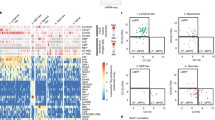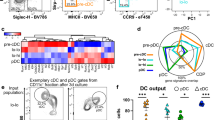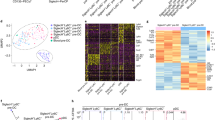Abstract
Expression of the cell-surface antigen CD10 has long been used to define the lymphoid commitment of human cells. Here we report a unique lymphoid-primed population in human bone marrow that was generated from hematopoietic stem cells (HSCs) before onset of the expression of CD10 and commitment to the B cell lineage. We identified this subset by high expression of the homing molecule L-selectin (CD62L). CD10−CD62Lhi progenitors had full lymphoid and monocytic potential but lacked erythroid potential. Gene-expression profiling placed the CD10−CD62Lhi population at an intermediate stage of differentiation between HSCs and lineage-negative (Lin−) CD34+CD10+ progenitors. CD62L was expressed on immature thymocytes, and its ligands were expressed at the cortico-medullary junction of the thymus, which suggested a possible role for this molecule in homing to the thymus. Our studies identify the earliest stage of lymphoid priming in human bone marrow.
This is a preview of subscription content, access via your institution
Access options
Subscribe to this journal
Receive 12 print issues and online access
$209.00 per year
only $17.42 per issue
Buy this article
- Purchase on Springer Link
- Instant access to full article PDF
Prices may be subject to local taxes which are calculated during checkout






Similar content being viewed by others
Accession codes
References
Kondo, M., Weissman, I.L. & Akashi, K. Identification of clonogenic common lymphoid progenitors in mouse bone marrow. Cell 91, 661–672 (1997).
Adolfsson, J. et al. Identification of Flt3+ lympho-myeloid stem cells lacking erythro-megakaryocytic potential a revised road map for adult blood lineage commitment. Cell 121, 295–306 (2005).
Forsberg, E.C., Serwold, T., Kogan, S., Weissman, I.L. & Passegue, E. New evidence supporting megakaryocyte-erythrocyte potential of flk2/flt3+ multipotent hematopoietic progenitors. Cell 126, 415–426 (2006).
Schlenner, S.M. & Rodewald, H.R. Early T cell development and the pitfalls of potential. Trends Immunol. 31, 303–310 (2010).
Richie Ehrlich, L.I., Serwold, T. & Weissman, I.L. In vitro assays misrepresent in vivo lineage potentials of murine lymphoid progenitors. Blood 117, 2618–2624 (2011).
Payne, K.J. & Crooks, G.M. Immune-cell lineage commitment: translation from mice to humans. Immunity 26, 674–677 (2007).
Rossi, M.I. et al. B lymphopoiesis is active throughout human life, but there are developmental age-related changes. Blood 101, 576–584 (2003).
Mold, J.E. et al. Fetal and adult hematopoietic stem cells give rise to distinct T cell lineages in humans. Science 330, 1695–1699 (2010).
Leavy, O. Haematopoiesis: baby tolerance. Nat. Rev. Immunol. 11, 78 (2011).
Galy, A., Travis, M., Cen, D. & Chen, B. Human T, B, natural killer, and dendritic cells arise from a common bone marrow progenitor cell subset. Immunity 3, 459–473 (1995).
Ichii, M. et al. The density of CD10 corresponds to commitment and progression in the human B lymphoid lineage. PLoS ONE 5, e12954 (2010).
Six, E.M. et al. A human postnatal lymphoid progenitor capable of circulating and seeding the thymus. J. Exp. Med. 204, 3085–3093 (2007).
Rosen, S.D. Ligands for L-selectin: homing, inflammation, and beyond. Annu. Rev. Immunol. 22, 129–156 (2004).
Cho, S. & Spangrude, G.J. Enrichment of functionally distinct mouse hematopoietic progenitor cell populations using CD62L. J. Immunol. 187, 5203–5210 (2011).
Perry, S.S. et al. L-selectin defines a bone marrow analog to the thymic early T-lineage progenitor. Blood 103, 2990–2996 (2004).
Perry, S.S., Welner, R.S., Kouro, T., Kincade, P.W. & Sun, X.H. Primitive lymphoid progenitors in bone marrow with T lineage reconstituting potential. J. Immunol. 177, 2880–2887 (2006).
Hao, Q.L. et al. Identification of a novel, human multilymphoid progenitor in cord blood. Blood 97, 3683–3690 (2001).
Storms, R.W., Goodell, M.A., Fisher, A., Mulligan, R.C. & Smith, C. Hoechst dye efflux reveals a novel CD7+CD34− lymphoid progenitor in human umbilical cord blood. Blood 96, 2125–2133 (2000).
Haddad, R. et al. Molecular characterization of early human T/NK and B-lymphoid progenitor cells in umbilical cord blood. Blood 104, 3918–3926 (2004).
Hoebeke, I. et al. T-, B- and NK-lymphoid, but not myeloid cells arise from human CD34+CD38−CD7+ common lymphoid progenitors expressing lymphoid-specific genes. Leukemia 21, 311–319 (2007).
Doulatov, S. et al. Revised map of the human progenitor hierarchy shows the origin of macrophages and dendritic cells in early lymphoid development. Nat. Immunol. 11, 585–593 (2010).
Manz, M.G., Miyamoto, T., Akashi, K. & Weissman, I.L. Prospective isolation of human clonogenic common myeloid progenitors. Proc. Natl. Acad. Sci. USA 99, 11872–11877 (2002).
La Motte-Mohs, R.N., Herer, E. & Zuniga-Pflucker, J.C. Induction of T-cell development from human cord blood hematopoietic stem cells by Delta-like 1 in vitro. Blood 105, 1431–1439 (2005).
Majewski, I.J. et al. Opposing roles of polycomb repressive complexes in hematopoietic stem and progenitor cells. Blood 116, 731–739 (2010).
Blom, B. & Spits, H. Development of human lymphoid cells. Annu. Rev. Immunol. 24, 287–320 (2006).
Biassoni, R., Ferrini, S., Prigione, I., Moretta, A. & Long, E.O. CD3-negative lymphokine-activated cytotoxic cells express the CD3ɛ gene. J. Immunol. 140, 1685–1689 (1988).
Lanier, L.L., Chang, C., Spits, H. & Phillips, J.H. Expression of cytoplasmic CD3 epsilon proteins in activated human adult natural killer (NK) cells and CD3 γ, δ, ɛ complexes in fetal NK cells. Implications for the relationship of NK and T lymphocytes. J. Immunol. 149, 1876–1880 (1992).
Misslitz, A. et al. Thymic T cell development and progenitor localization depend on CCR7. J. Exp. Med. 200, 481–491 (2004).
Krueger, A., Willenzon, S., Lyszkiewicz, M., Kremmer, E. & Forster, R. CC chemokine receptor 7 and 9 double-deficient hematopoietic progenitors are severely impaired in seeding the adult thymus. Blood 115, 1906–1912 (2010).
Zlotoff, D.A. et al. CCR7 and CCR9 together recruit hematopoietic progenitors to the adult thymus. Blood 115, 1897–1905 (2010).
Streeter, P.R., Rouse, B.T. & Butcher, E.C. Immunohistologic and functional characterization of a vascular addressin involved in lymphocyte homing into peripheral lymph nodes. J. Cell Biol. 107, 1853–1862 (1988).
Arakawa-Hoyt, J. et al. The number and generative capacity of human B lymphocyte progenitors, measured in vitro and in vivo, is higher in umbilical cord blood than in adult or pediatric bone marrow. Bone Marrow Transplant. 24, 1167–1176 (1999).
Kim, D.K. et al. Comparison of hematopoietic activities of human bone marrow and umbilical cord blood CD34 positive and negative cells. Stem Cells 17, 286–294 (1999).
De Smedt, M. et al. T-lymphoid differentiation potential measured in vitro is higher in CD34+CD38−/lo hematopoietic stem cells from umbilical cord blood than from bone marrow and is an intrinsic property of the cells. Haematologica 96, 646–654 (2011).
Bhatia, M., Wang, J.C., Kapp, U., Bonnet, D. & Dick, J.E. Purification of primitive human hematopoietic cells capable of repopulating immune-deficient mice. Proc. Natl. Acad. Sci. USA 94, 5320–5325 (1997).
Månsson, R. et al. Molecular evidence for hierarchical transcriptional lineage priming in fetal and adult stem cells and multipotent progenitors. Immunity 26, 407–419 (2007).
Luc, S. et al. Down-regulation of Mpl marks the transition to lymphoid-primed multipotent progenitors with gradual loss of granulocyte-monocyte potential. Blood 111, 3424–3434 (2008).
Dias, S., Mansson, R., Gurbuxani, S., Sigvardsson, M. & Kee, B.L. E2A proteins promote development of lymphoid-primed multipotent progenitors. Immunity 29, 217–227 (2008).
Hao, Q.L. et al. Human intrathymic lineage commitment is marked by differential CD7 expression: identification of CD7− lympho-myeloid thymic progenitors. Blood 111, 1318–1326 (2008).
Rossi, F.M. et al. Recruitment of adult thymic progenitors is regulated by P-selectin and its ligand PSGL-1. Nat. Immunol. 6, 626–634 (2005).
Holmes, R. & Zuniga-Pflucker, J.C. The OP9–DL1 system: generation of T-lymphocytes from embryonic or hematopoietic stem cells in vitro. Cold Spring Harb. Protoc. doi:10.1101/pdb.prot5156 (2009).
Vandesompele, J. et al. Accurate normalization of real-time quantitative RT-PCR data by geometric averaging of multiple internal control genes. Genome Biol. 3, research0034–research0034.11 (2002).
Bolstad, B.M., Irizarry, R.A., Astrand, M. & Speed, T.P. A comparison of normalization methods for high density oligonucleotide array data based on variance and bias. Bioinformatics 19, 185–193 (2003).
Liu, W.M. et al. Analysis of high density expression microarrays with signed-rank call algorithms. Bioinformatics 18, 1593–1599 (2002).
Gentleman, R.C. et al. Bioconductor: open software development for computational biology and bioinformatics. Genome Biol. 5, R80 (2004).
Smyth, G.K. Bioinformatics and Computational Biology Solutions using R and Bioconductor, R (eds. Gentleman, R., Carey, V., Dudoit, S., Irizarry, R. & Huber, W.) 387–420 (Springer, 2005).
Subramanian, A. et al. Gene set enrichment analysis: a knowledge-based approach for interpreting genome-wide expression profiles. Proc. Natl. Acad. Sci. USA 102, 15545–15550 (2005).
de Hoon, M.J., Imoto, S., Nolan, J. & Miyano, S. Open source clustering software. Bioinformatics 20, 1453–1454 (2004).
Saldanha, A.J. Java Treeview–extensible visualization of microarray data. Bioinformatics 20, 3246–3248 (2004).
Hu, Y. & Smyth, G.K. ELDA: extreme limiting dilution analysis for comparing depleted and enriched populations in stem cell and other assays. J. Immunol. Methods 347, 70–78 (2009).
Acknowledgements
We thank J. Scholes, F. Codrea, X. Li and S. Dandekar for technical assistance; and D. Kohn, G. Dravid, S. Sandoval and M. Corselli for advice on the manuscript. Supported by the US National Institutes of Health (P01 HL073104 and RO1 HL077912), the California Institute of Regenerative Medicine (RC1-00108 and RM1-01717 to G.M.C.; and RN1-00557-1 to H.K.A.M.), Flow Cytometry Core of the Broad Stem Cell Research Center of the University of California, Los Angeles, and the Jonsson Comprehensive Cancer Center Genomics Shared Resource of the University of California, Los Angeles.
Author information
Authors and Affiliations
Contributions
L.A.K. designed, did and analyzed experiments and wrote the paper; Q.-L.H. designed, did and analyzed experiments, R.S. did bioinformatics analysis of microarray data; S.G. and Y.Z. assisted in experiments; C.P. did experiments; H.K.A.M. supervised bioinformatics analysis; and G.M.C. designed and analyzed experiments and wrote the paper.
Corresponding author
Ethics declarations
Competing interests
The authors declare no competing financial interests.
Supplementary information
Supplementary Text and Figures
Supplementary Figures 1–7 and Tables 1–3 (PDF 1924 kb)
Rights and permissions
About this article
Cite this article
Kohn, L., Hao, QL., Sasidharan, R. et al. Lymphoid priming in human bone marrow begins before expression of CD10 with upregulation of L-selectin. Nat Immunol 13, 963–971 (2012). https://doi.org/10.1038/ni.2405
Received:
Accepted:
Published:
Issue Date:
DOI: https://doi.org/10.1038/ni.2405
This article is cited by
-
Generation and clinical potential of functional T lymphocytes from gene-edited pluripotent stem cells
Experimental Hematology & Oncology (2022)
-
A transcriptomic continuum of differentiation arrest identifies myeloid interface acute leukemias with poor prognosis
Leukemia (2021)
-
Long-term lymphoid progenitors independently sustain naïve T and NK cell production in humans
Nature Communications (2021)
-
On-chip recapitulation of clinical bone marrow toxicities and patient-specific pathophysiology
Nature Biomedical Engineering (2020)
-
From haematopoietic stem cells to complex differentiation landscapes
Nature (2018)



